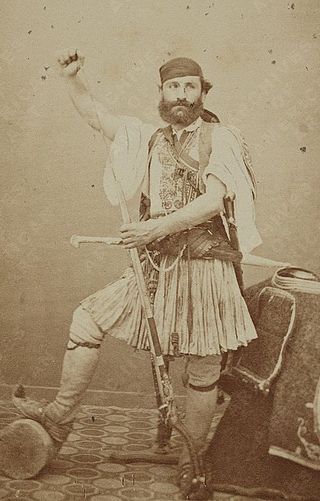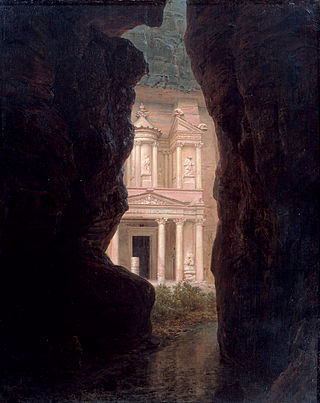
Frederic Edwin Church was an American landscape painter born in Hartford, Connecticut. He was a central figure in the Hudson River School of American landscape painters, best known for painting large landscapes, often depicting mountains, waterfalls, and sunsets. Church's paintings put an emphasis on realistic detail, dramatic light, and panoramic views. He debuted some of his major works in single-painting exhibitions to a paying and often enthralled audience in New York City. In his prime, he was one of the most famous painters in the United States.

Albert Bierstadt was a German American painter best known for his lavish, sweeping landscapes of the American West. He joined several journeys of the Westward Expansion to paint the scenes. He was not the first artist to record the sites, but he was the foremost painter of them for the remainder of the 19th century.

The Hudson River School was a mid-19th-century American art movement embodied by a group of landscape painters whose aesthetic vision was influenced by Romanticism. Early on, the paintings typically depicted the Hudson River Valley and the surrounding area, including the Catskill, Adirondack, and White Mountains.

Thomas Cole was an English-born American artist and the founder of the Hudson River School art movement. Cole is widely regarded as the first significant American landscape painter. He was known for his romantic landscape and history paintings. Influenced by European painters, but with a strong American sensibility, he was prolific throughout his career and worked primarily with oil on canvas. His paintings are typically allegoric and often depict small figures or structures set against moody and evocative natural landscapes. They are usually escapist, framing the New World as a natural eden contrasting with the smog-filled cityscapes of Industrial Revolution-era Britain, in which he grew up. His works, often seen as conservative, criticize the contemporary trends of industrialism, urbanism, and westward expansion.

Martin Johnson Heade was an American painter known for his salt marsh landscapes, seascapes, and depictions of tropical birds, as well as lotus blossoms and other still lifes. His painting style and subject matter, while derived from the romanticism of the time, are regarded by art historians as a significant departure from those of his peers.

Luminism is an American landscape painting style of the 1850s to 1870s, characterized by effects of light in landscape, through the use of aerial perspective and the concealment of visible brushstrokes. Luminist landscapes emphasize tranquility, and often depict calm, reflective water and a soft, hazy sky. Artists who were most central to the development of the luminist style include Fitz Hugh Lane, Martin Johnson Heade, Sanford Gifford, and John F. Kensett. Painters with a less clear affiliation include Frederic Edwin Church, Jasper Cropsey, Albert Bierstadt, Worthington Whittredge, Raymond Dabb Yelland, Alfred Thompson Bricher, James Augustus Suydam, and David Johnson. Some precursor artists are George Harvey and Robert Salmon. Joseph Rusling Meeker also worked in the style.

Olana State Historic Site is a historic house museum and landscape in Greenport, New York, near the city of Hudson. The estate was home to Frederic Edwin Church (1826–1900), one of the major figures in the Hudson River School of landscape painting. The centerpiece of Olana is an eclectic villa which overlooks parkland and a working farm designed by the artist. The residence has a wide view of the Hudson River Valley, the Catskill Mountains and the Taconic Range. Church and his wife Isabel (1836–1899) named their estate after a fortress-treasure house in ancient Greater Persia, which also overlooked a river valley.

The Heart of the Andes is a large oil-on-canvas landscape painting by the American artist Frederic Edwin Church (1826–1900). It depicts an idealized landscape in the South American Andes, where Church traveled on two occasions. Measuring more than five feet high and almost ten feet wide, its New York City exhibition in 1859 was a sensation, establishing Church as the foremost landscape painter in the United States.

Lockwood de Forest was an American painter, interior designer and furniture designer. A key figure in the Aesthetic Movement, he introduced the East Indian craft revival to Gilded Age America.

The Icebergs is an 1861 oil painting by the American landscape artist Frederic Edwin Church. It was inspired by his 1859 voyage to the North Atlantic around Newfoundland and Labrador. Considered one of Church's "Great Pictures"—measuring 1.64 by 2.85 metres —the painting depicts one or more icebergs in the afternoon light of the Arctic. It was first displayed in New York City in 1861, where visitors paid 25 cents' admittance to the one-painting show. Similar exhibitions in Boston and London followed. The unconventional landscape of ice, water, and sky generally drew praise, but the American Civil War, which began the same year, lessened critical and popular interest in New York City's cultural events.

The Arch of Titus is an 1871 oil painting on canvas. It was a collaboration between three American painters: George Peter Alexander Healy, Frederic E. Church, and Jervis McEntee. It depicts the Arch of Titus in Rome, with the Colosseum in the background, and includes portraits of Henry Wadsworth Longfellow and his daughter Edith, and the three artists. The painting is currently on display in the Newark Museum in Newark, New Jersey.

Niagara Falls, from the American Side is a painting by the American artist Frederic Edwin Church (1826–1900). Completed in 1867, it is based on preliminary sketches made by the artist at Niagara Falls and on a sepia photograph. It is Church's largest painting. The painting is now in the collection of the Scottish National Gallery. Church was a leading member of the Hudson River School of painters.

The Aegean Sea is a c. 1877 oil painting by American artist Frederic Edwin Church, and one of his last large-scale paintings.

The Andes of Ecuador is an 1855 oil painting by Frederic Edwin Church, the premier American landscape painter of the time. It is the most significant result of his 1853 trip to South America, where he would travel again in 1857. It is Church's first major painting, his largest work to date, and "an early masterpiece of Luminism", according to the Reynolda House Museum of American Art in Winston-Salem, North Carolina, which holds the painting.

Twilight in the Wilderness is an 1860 oil painting by American painter Frederic Edwin Church. The woodlands of the northeastern United States are shown against a setting sun that intensely colors the dramatic altocumulus clouds. Church scholar John K. Howat describes the painting as "one of his finest ever" and as "the single most impressive example of Church's depictions of unsullied North American woodlands and their most famous representation in nineteenth-century painting".

El Khasné, Petra is an 1874 oil painting by American landscape artist Frederic Edwin Church. It is a depiction of the Al-Khazneh temple in the historical city of Petra, Jordan, which Church visited during an extended trip to the Middle East and Europe in 1867 and 1868. He visited the tomb with American missionary D. Stuart Dodge in February 1868 and made sketches there. The painting is located at Olana State Historic Site, the preserved homestead where Church lived in his later years. It may be the last canvas that he painted entirely with his right hand, owing to worsening rheumatoid arthritis.

Approaching Thunder Storm is an 1859 painting by American painter Martin Johnson Heade. It was his largest painting to date. The painting is in the collection of the Metropolitan Museum of Art. It is praised for its dramatic depiction of the threatening mood of blackening skies and eerily illuminated terrain prior to the storm itself. The painting has been connected to mounting tensions before the Civil War, which were often expressed in terms of natural imagery.

Cotopaxi is an 1862 oil painting by American artist Frederic Edwin Church, a member of the Hudson River School. The painting depicts Cotopaxi, an active volcano that is also the second highest peak in modern-day Ecuador, spewing smoke and ash across a colorful sunrise. The work was commissioned by well-known philanthropist and collector James Lenox and was first exhibited in New York City in 1863. Cotopaxi was met with great acclaim, seen by some as a "parable" of the Civil War, then raging in the American South, with its casting of light against darkness in a vast tropical landscape. Church first depicted Cotopaxi beginning in 1853 during his first of several travels to South America, forming a series of at least 10 paintings on the subject during his lifetime. Cotopaxi has been called by some art historians the "apex" of the Cotopaxi series or Church's "ultimate interpretation" of the eponymous volcano.

Landscape with Rainbow is an oil on canvas painting by the African-American artist Robert S. Duncanson. The Hudson River School landscape painting was completed in 1859, while Duncanson was living in Cincinnati, Ohio. It has been in the collection of the Smithsonian American Art Museum in Washington, D.C. since 1983.

Orchid and Hummingbirds near a Mountain Lake is a painting by Martin Johnson Heade, which he completed sometime between 1875 and 1890. Some scholars see the sensual depiction of the orchid and the nearly touching beaks of the birds as conveying romantic or even sexual overtones. Others see Heade's interest in orchids and hummingbirds as an exploration of dominance and survival in nature, perhaps inspired by Charles Darwin's evolutionary theory. The work is now in the collection of the McMullen Museum of Art at Boston College, having been donated as part of the Carolyn A. and Peter S. Lynch collection.






















